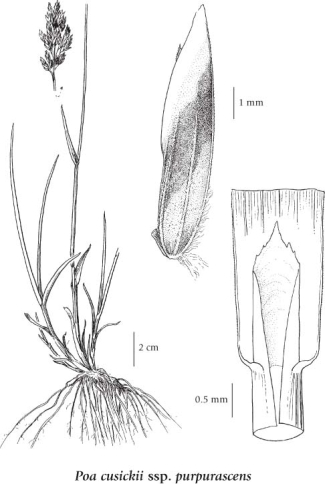Poa cusickii subsp. purpurascens Vasey (Vasey) Soreng
Cusick's bluegrass
Poaceae (Grass family)
Introduction to Vascular Plants
Cusick's bluegrass
Poaceae (Grass family)
Introduction to Vascular Plants
Map
Distribution of Poa cusickii subsp. purpurascens
Click here to view the full interactive map and legend
Species Information
General:
Perennial, densely tufted grass from fibrous roots; stems erect or decumbent, 10-50 cm tall/long.
Leaves:
Sheath margins open 1/4-3/4 their length; sterile shoots emerging inside sheaths, or also breaking through sheath bases; blades 0.5-2 mm wide, those of sterile shoots in-rolled, moderately thick, outer surface smooth or rough, inner surface usually distinctly rough or minutely soft-hairy, leaf blades of lateral shoots folded to in-rolled and rough to more or less stiff-hairy on and between the veins of the upper surfaces; ligules of sterile shoots 0.5-2.5 mm long, the tips blunt to rounded, the backs rough.
Flowers:
Inflorescence of mostly erect panicles, 2-12 cm long, mostly congested, lanceolate to egg-shaped, the branches 1 to 2 per node, appressed or steeply ascending, moderately strict, smooth or rough; spikelets strongly laterally compressed, (3) 4-8 (10) mm long, 2- to 6-flowered; glumes unequal, the lower ones 3.5-5 mm long, 3-nerved, the upper ones 4.5-6 mm long; rachillas smooth or rough; lemmas lanceolate to broadly lanceolate, 4-7 mm long, the tips sharp-pointed, surface membranous, smooth or rough, hairless (or keel and marginal nerves minutely soft-hairy below in ssp. purpurascens), lateral nerves obscure to prominent; calluses hairless (or short, sparsely cobwebby in ssp. purpurascens); palea keels rough; flowers usually unisexual; anthers vestigial, aborted late in development, or 2-3.5 mm long.
Notes:
Three subspecies occur in BC. These include two female, apomictic subspecies (ssp. epilis and ssp. purpurascens) and a sexual, although often apomictic subspecies (ssp. Pallida).
1. Basal tuft of leaves dense, basal shoots arising from within the sheaths, lacking bladeless leaves below; all stem nodes enclosed in the sheaths or the uppermost barely exposed; stem leaf blades similar to, or somewhat broader than those of the basal shoots, rarely flat, blades of basal shoots more or less threadlike, mostly less than 1 mm wide when expanded................ ssp. pallida Soreng
1. Basal tuft of leaves looser, basal shoots, in part, arising externally to the sheath, with bladeless leaves below; at least one stem node well exserted and exposed at maturity; stem leaf blades frequently wider than those of the basal shoots, and flat or folded, basal shoot blades up to 3 mm wide when expanded.
2. Lemmas of at least some of the lower florets of some spikelets very sparsely to moderately hairy on the base of the keels and frequently with a few hairs on the calluses; panicles loosely contracted and with less than 20 spikelets..................... ssp. purpurascens (Vasey) Soreng
2. Lemmas of all florets smooth to rough; panicles tending to be compact, strict, and with more than 20 spikelets................... ssp. epilis (Scribn.) Weber
Illustration

If more than one illustration is available for a species (e.g., separate illustrations were provided for two subspecies) then links to the separate images will be provided below. Note that individual subspecies or varietal illustrations are not always available.
Illustration Source: The Illustrated Flora of British Columbia
Ecology
Ecological Framework for Poa cusickii ssp. purpurascens
The table below shows the species-specific information calculated from
original data (BEC database) provided by the BC Ministry of Forests and Range.
(Updated August, 2013)
The table below shows the species-specific information calculated from
original data (BEC database) provided by the BC Ministry of Forests and Range.
(Updated August, 2013)
| Site Information |
Value / Class |
||
|
Avg |
Min |
Max |
|
| Elevation
(metres) |
850 | 840 | 860 |
| Slope
Gradient (%) |
13 | 4 | 23 |
|
Aspect (degrees) |
96 | 50 | 143 |
| Soil
Moisture Regime (SMR) [0 - very xeric; 4 - mesic; 8 - hydric] |
2 | 2 | 3 |
| Modal
Nutrient Regime
Class |
C | ||
| #
of field plots species was recorded in: |
4 | ||
| Modal
BEC Zone Class |
BG | ||
|
All BEC Zones (# of stations/zone) species was recorded in |
BG(2) | ||
|
Source:
Klinkenberg 2013
|
|||
Habitat and Range
Dry to mesic meadows, talus slopes and ridges in the montane to lower alpine zones; ssp. epilis - frequent throughout BC; ssp. pallida - infrequent in SE BC; ssp. purpurascens - frequent in SC and SW BC; ssp. epilis - E to AB and S to CO, UT, NV and CA; ssp. pallida - N to S YT, E to MB and S to ND, CO, UT, NV and CA; ssp. purpurascens - S to CA.Status Information
Synonyms
Synonyms and Alternate Names:
Poa alpina var. purpurascens
Poa cusickii var. purpurascens (Vasey) C.L. Hitchc.
Poa purpurascens
